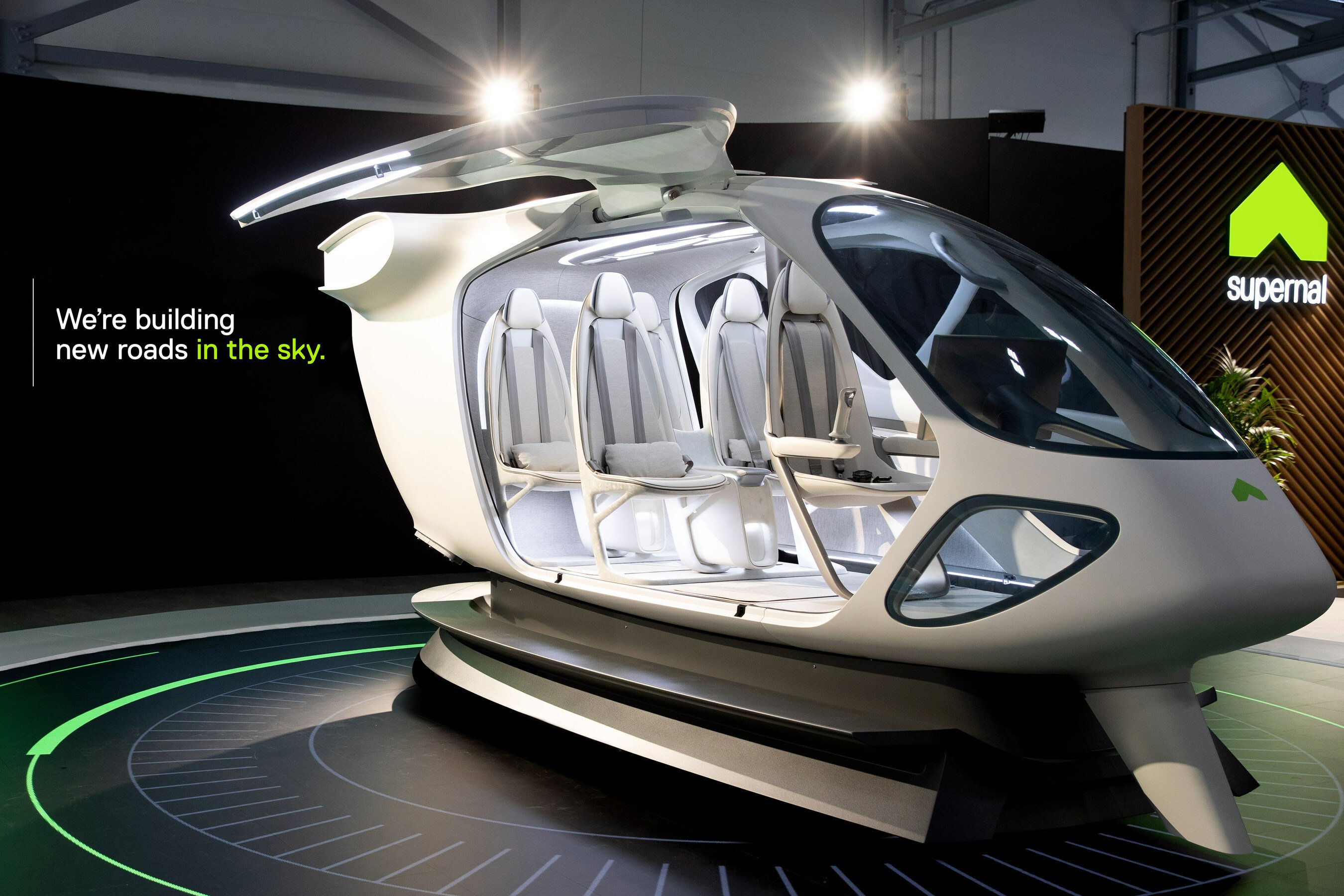With so much of the efforts to bring eVTOL aircraft into commercial service focused on new propulsion systems and automated flight controls, the interiors of these vehicles have been largely overlooked. Air taxi services could start in 2025 and yet hardly any of the prospective passengers have yet been given the faintest idea of what the cabin experience will be like.
This could be changing, though, with manufacturers starting to lift the veil on the cabins in which, typically, four or five passengers will be carried across cities from one vertiport to another, or perhaps to and from existing airports. In the coming months, several big reveals are anticipated that will give a clear impression of the electric air taxi experience.
This week, Supernal announced that it has been recognized in the International Forum (IF) Design Award competition for the cabin concept it first displayed at the 2022 Farnborough International Air Show. The cabin, for the SA-1 aircraft, was conceived by designers from the U.S.-based start-up’s parent company, which is the Korean car maker Hyundai.
According to Supernal, the five-seat cabin (including one seat for the pilot) harnesses the automotive design processes and materials that are expected to support high-volume manufacturing while meeting stringent aviation safety standards. Announcing the IF Design Award, it said that the concept is based on biomimicry principles that take lessons from the natural world, while also putting safety, passenger comfort, and environmental responsibility at the forefront.
The cabin fittings use advanced recyclable lightweight carbon fiber reinforced thermoplastic, durable plant-based leather, recycled plastic fabric, and responsibly sourced woods. The seat frames also use excess raw materials from the airframe manufacturing process.
The cabin features ergonomically contoured seats that Supernal says give the feel of a cocoon, as well as deployable seat consoles that provide passengers with a charging station for their devices and a storage compartment for personal items. "Grab handles" are built into the cabin doors and seatbacks to assist people in getting in and out of the cabin. Overhead lighting inspired by car sunroofs adjusts to the different phases of flight to provide what the manufacturer says is a light therapy effect.
The competition received 11,000 entries from 56 countries. The IF jury judged nominees on criteria that included idea, form, function, differentiation, and impact. The award will be presented on May 15 at a ceremony in Berlin.
“One of the most important parameters for a designer is to learn,” commented Luc Donckerwolke, chief creative officer of the Hyundai Motor Group in a written statement. “To be confronted by the influential factors required to design an aircraft, therefore, boosts our creativity. My team and I truly enjoyed exploring ideas, taking into account physics, aerodynamics, and ergonomics of a new mobility concept, and designing the journey; the experience of the passenger in future eVTOL mobility.”
Luxury Auto Veteran Stephenson Turns His Eye to AutoFlight, Lilium, and Archer
Supernal isn’t the only eVTOL market entrant looking to up its game when it comes to both the interior and exterior look of its aircraft. China-based AutoFlight recently named seasoned automotive designer Frank Stephenson as the director of design for its Prosperity I vehicle. UK-based Stephenson—who over three decades has contributed to the designs of cars from leading brands such as Ferrari, Maserati, McLaren, BMW, and Mini—is also working on the design of Archer’s Midnight model and the Lilium Jet.
“Frank is one of the world’s most renowned and influential designers of our time,” said Mark Henning, managing director of AutoFlight Europe. “His unique style is already evident on the Prosperity I with its sleek, sculpted uncluttered, and dynamic feel that has been inspired by a natural sense of flow and dynamics.”
Beyond the cabin, Frank Stephenson’s team works with its customers' engineers to address design priorities and requirements for all aspects of the product, including the airframe, and take account of operational requirements for the aircraft, such as ground handling. “It’s a collaborative process,” he told FutureFlight. “We want to work with the engineers to make something that is feasible but at the same time, it has to look spectacular. It’s about striking the balance between design and engineering.”
For companies like AutoFlight, Lilium, and Archer, Frank Stephenson Design acts as an in-house or satellite design studio. “Working in the eVTOL industry requires a great deal of flexibility, mainly because the technology is so new. All the regulations for safety and comparability are being developed concurrently with our own design work,” Stephenson said.
In marked contrast to the high-tech feel of the advanced air mobility sector, the designs start with a pen and paper, which the company feels is an important prerequisite to retain a human touch. In the early stages, the team explores multiple concepts to comprehend “the full bandwidth of potential” before condensing and refining their ideas to take account of factors such as weight and safety.
“At this stage, we begin to translate our 2D imagery into 3D virtual and physical models,” explained Stephenson. “Here we can solve many of the ergonomic and packaging challenges that arise when designing an aircraft.”
Many aspects of the design for the external airframe are driven by core factors such as the architecture of the wings and propellers. It is inside the aircraft that the designers generally have more freedom.
“The interior [eVTOL] concept is very unique,” Stephenson reflected. “It’s a new type of space and a very interesting package to execute. The cross-sectional area should be minimized to reduce drag, and at the same time the cabin has to be comfortable and spacious enough for the passengers.”
